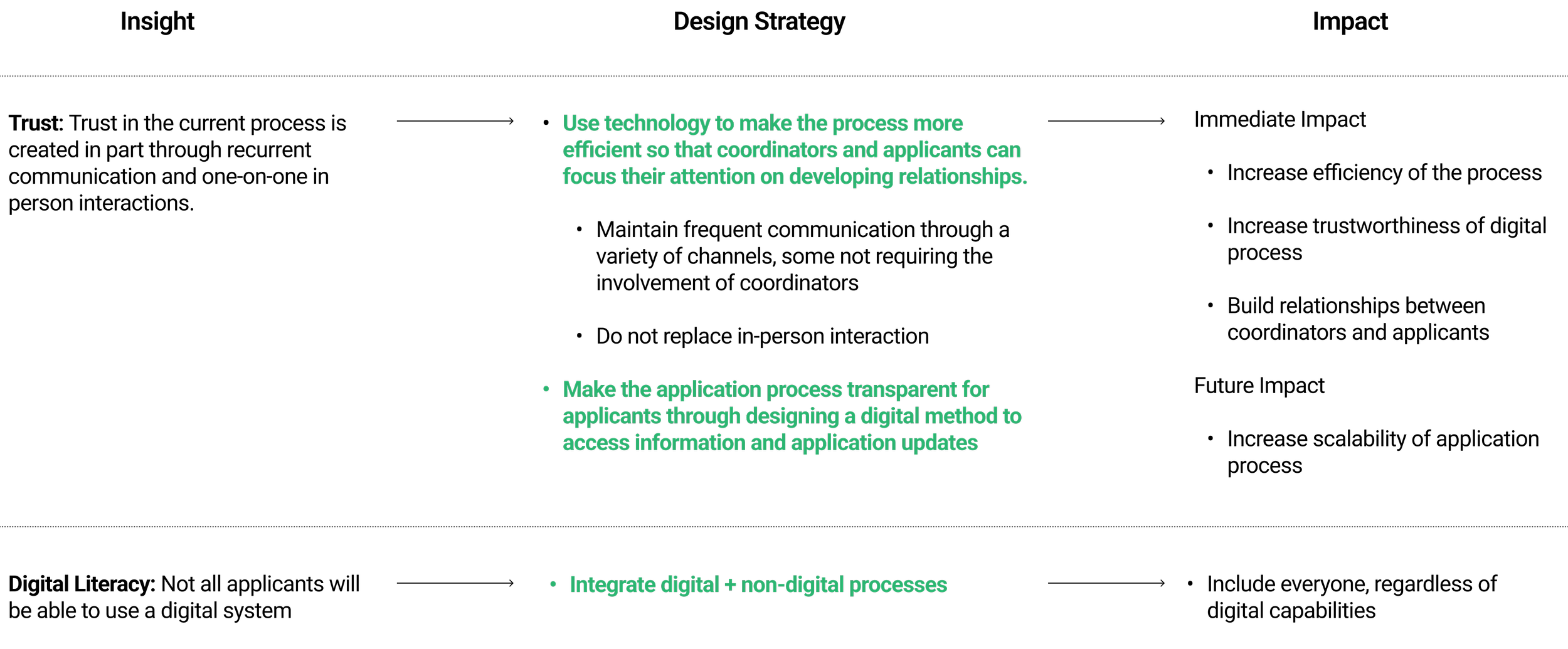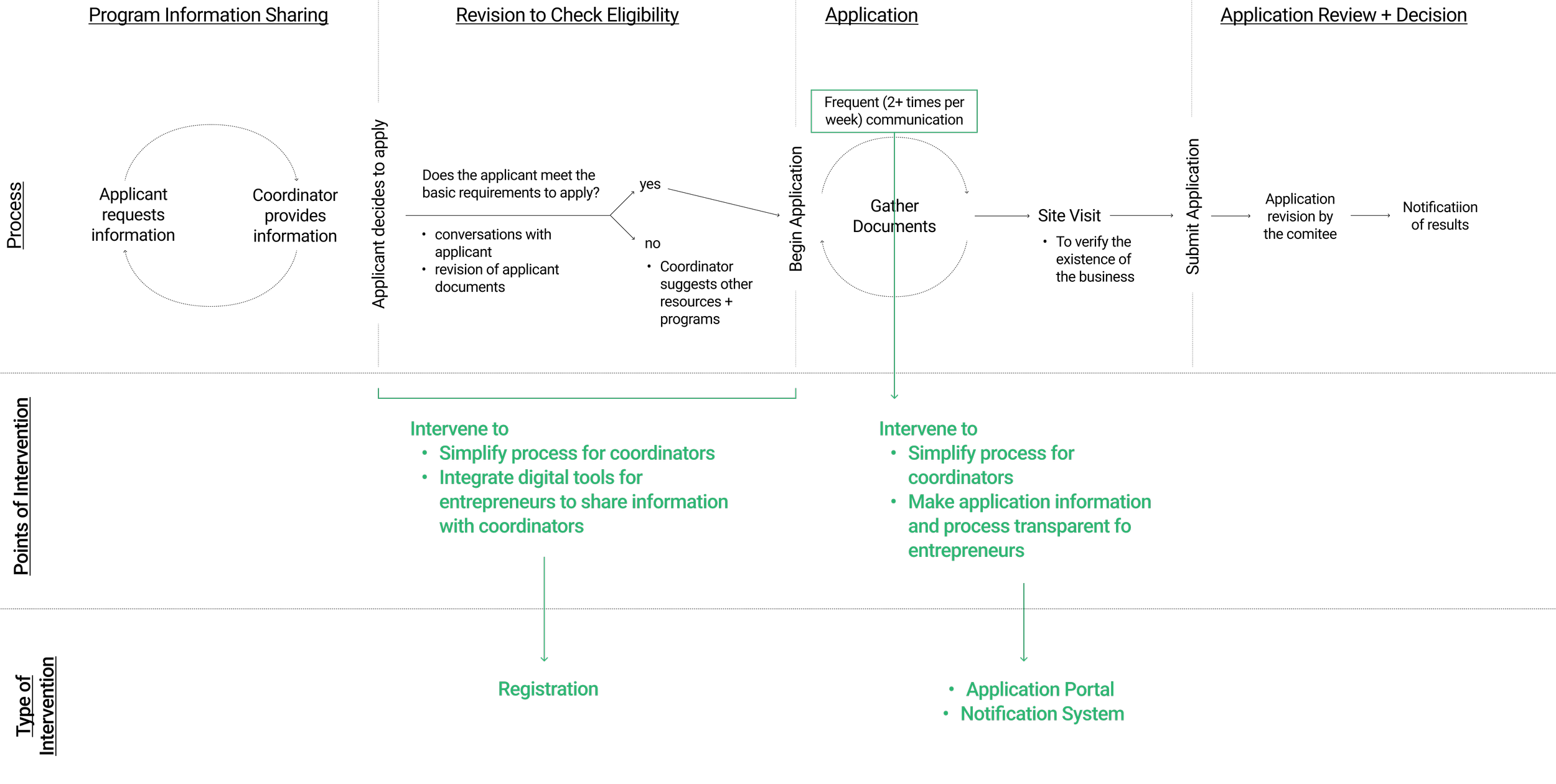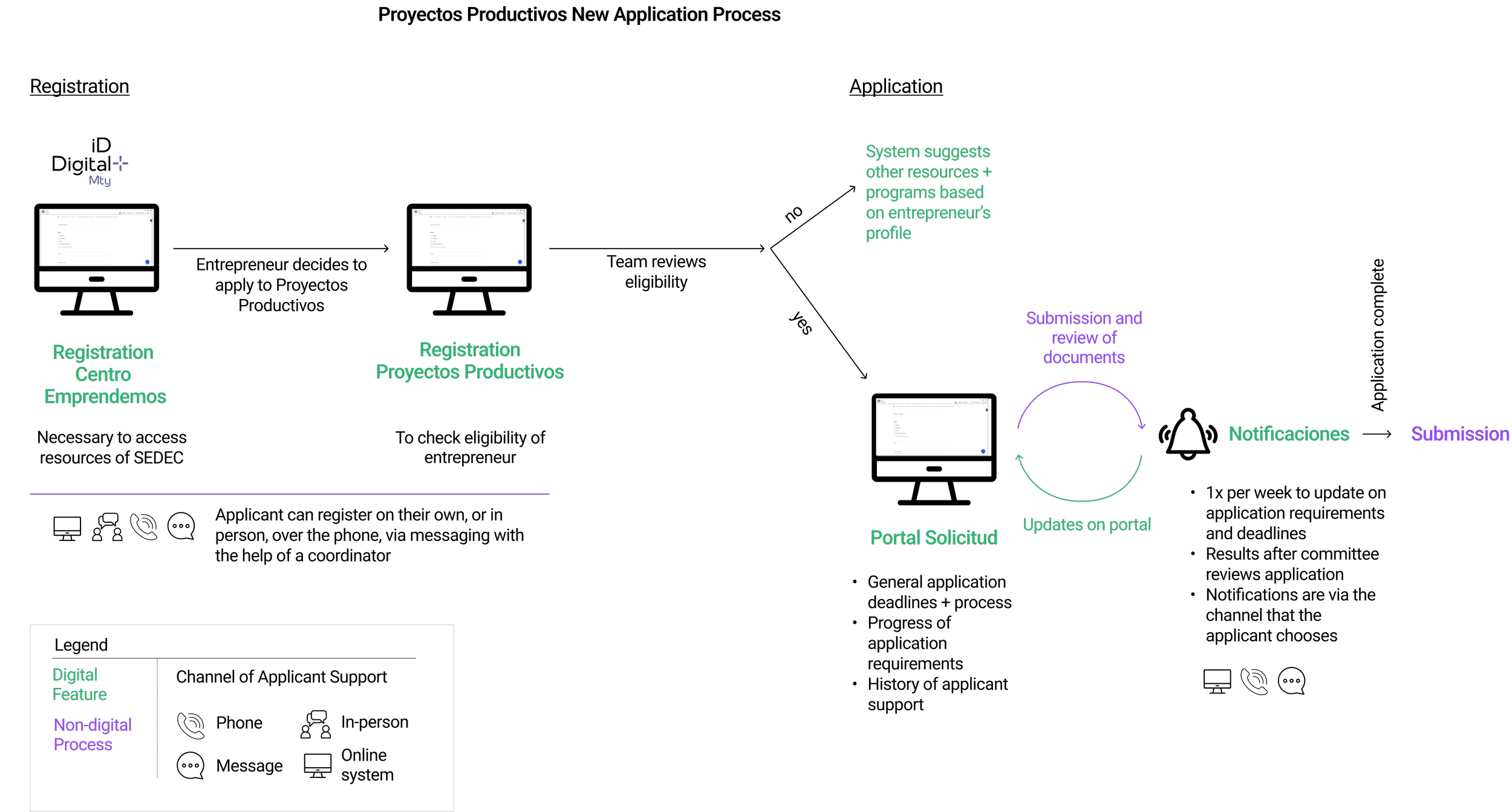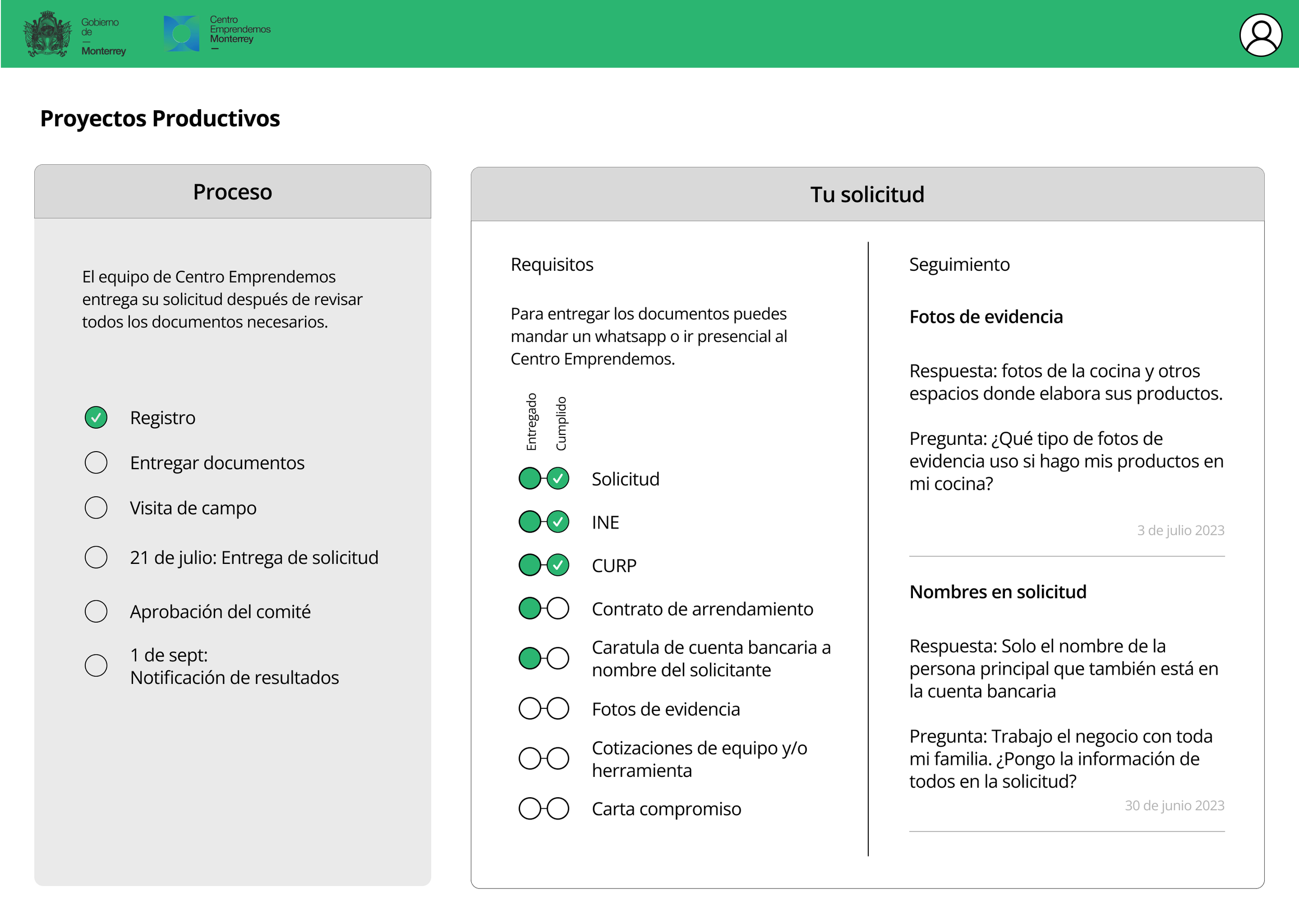Proyectos Productivos: Economic Support Program Application
My Role: UX Designer and Researcher
Methods: Field studies, user interviews, literature review and synthesis, policy analysis
Client: City of Monterrey, Mexico - Department of Innovation and Open Government and Department of Economic Development
Sponsoring Institutions: Harvard Bloomberg City Leadership Initiative, Banco Interamericano de Desarrollo
Collaborators: Samantha Alcaraz, Emmanuel García Castro, Silvia Hernández Garza, Andres Moreno Frese, Janeth Luna
Duration: 10 weeks
problem
Proyectos Productivos is an economic support program run by the City of Monterrey, Mexico. It provides small businesses with grants and financial education in order to scale their operations. Currently, the application process is not digitized, leading to various inefficiencies for the project team and entrepreneurs who apply, and making it difficult to collect data that can measure program outcomes and pinpoint necessary improvements.
Through piloting a new digital application process, we sought to improve the experience of coordinators and entrepreneurs, and gain insights that we could scale to other departments within the city.
QUESTION
How can we improve the application process for the economic support program Proyectos Productivos to make it more efficient for coordinators and more transparent for applicants?
research
Research: Current application process
In the present non-digital system, project coordinators support applicants through in-person meetings, and phone calls and instant messages from their personal cell phones. Through this communication, coordinators
Guide the applicants through the entire application process
Remind entrepreneurs of deadlines and the application requirements they are missing
Assist applicants in filling out the application and acquiring missing documents
Answer any questions or concerns of the applicant
In addition, business owners often have to travel to the office of the Department of Economic Development (Secretaría de Desarrollo Económico) for meetings and to turn in physical copies of documents.
Application and tracking of application progress are stored in paper folders.
Research: User insights
There are two users involved in the application process.
Coordinators, who run the program and take the lead on communication with the applicants.
Applicants, who are micro and small business owners often running their operations out of their homes and on limited budgets.
Coordinators
Efficiency:
The majority of their time (21 hours a week) is spent in communication of basic application information to the applicants.
Communication to answer applicants’ questions and concerns, especially when in-person, is important to building relationships with the applicants and creating trust in the program
Communication of basic application information is repetitive but necessary in the current process as the information is only available through talking directly to a coordinator (not online).
Physically printing and gathering documents in folders to send to the review committee is time consuming.
Application tracking: Manually filling out spreadsheets leads to the loss of important information to track application progress and past communication with applicants. Sometimes information is not entered fully or correctly.
Applicants
Transparency: Applicants consider the application process to be transparent because:
Roadmap: Coordinators provide them with an overview of the entire application process.
Nudges: Coordinators frequently remind them of the actions that need to be taken to complete their application.
Coordinators explain the entire process to them.
Trust
Frequent Positive Interactions: Trust in the process, the team, and Proyectos Productivos is created through frequent (2+ times per week) communication with coordinators.
In-person Meetings: Help build relationships between coordinators + applicants, generating trust in the team and indirectly the program.
Availability and Response Times: Quick response times by coordinators help applicants feel supported and build trust in the team. Applicants’ perception is that coordinators are always available.
Digital literacy
The majority of applicants use instant messaging as their primary method of communication.
Not all applicants have access to a computer and/or internet.
Research: Trust context + transparency
Trust context in Monterrey
Due to histories of corruption and violence initiated by the government, citizens have high levels of mistrust of the city. This mistrust is perpetually exacerbated by inefficient city processes in which city officials are slow to provide information, share inaccurate information, pass citizens from person to person, and/or require extensive documentation for access to information.
Within this project, we sought to uncover the aspects of the existing process that build trust, in order to design a trustworthy digital process. This was done through interviews with applicants, observation of in-person meetings between coordinators and applicants, and site visits to applicants’ businesses. The most important trust relationship for the success of Proyectos Productivos is that of the applicant with the coordinator.
Operational transparency in Monterrey
The internal operational processes of the city for petitions, applications, procedures, and requests for information are not available to citizens. For example, the city recently introduced a municipality-wide Customer Relationship Management system to track requests for information, complaints, and suggestions by citizens. However, citizens cannot access their case file nor are there established regulations for timelines for resolving the file, leaving the citizen in the dark and perpetuating a lack of trust in the city. In general, the lack of operational transparency necessitates that citizens must call or go in person to city offices for updates.
Design
Design: Strategies
Design: Points of Intervention
We intervened at two points in the process: the revision of applicant eligibility and the communication between applicants and coordinators once the application is started. These are the areas where there is tension between communication creating trust and inefficiency in the application process.
Design: New Application Process
The new process integrates 3 elements
Registration
Application portal
Notification system
The digital tools exist in parallel with existing processes, as a way to include all applicants regardless of digital education. For example, an applicant can go physically to the Department of Economic Development to meet with a coordinator, who will help them register and start their application.
Design: Registration
The digital registration includes
Questions, developed with coordinators, that allow them to determine whether someone can apply
Option for applicant to choose through what mode they want to receive communication for the remainder of the application process: email, text, call
Design: Application Portal
Allows the applicants to track the process of their application and their communication with the Proyectos Productivos team. The goal is to provide a clear and transparent method for applicants to access information, while also cutting down on coordinator time in updating applicants.
In a future phase of the project, this feature would become an online application portal.
Design: Notification System
Notifications alert the applicant
Once a week of their progress with their application
When the team submits their application
When application results are available
The weekly messages contain the same information as the requirements section of the portal. The goal of the notifications is to replace the work of coordinators in relaying basic information about progress to the applicants. Notifications are received via the mode that the applicant selected in their registration.
Learnings
Incrementally integrate the digital with the non-digital: In contexts with low digital literacy and inconsistent access to the internet, both digital and non-digital methods of applying must exist. In order to test the adoption of a digital process by a user group accustomed to non-digital processes, it is important to incrementally introduce the digital and measure the use and effects on the application process of each new digital tool.
A process can be trustworthy and inefficient simultaneously: Through first understanding what trust means in the context, seek to design something that remains trustworthy while also becoming more efficient.
Consider interoperability with existing systems from the beginning: Doing this in our project allowed us to integrate the city databases and digital ID into our system, which influenced our design.











